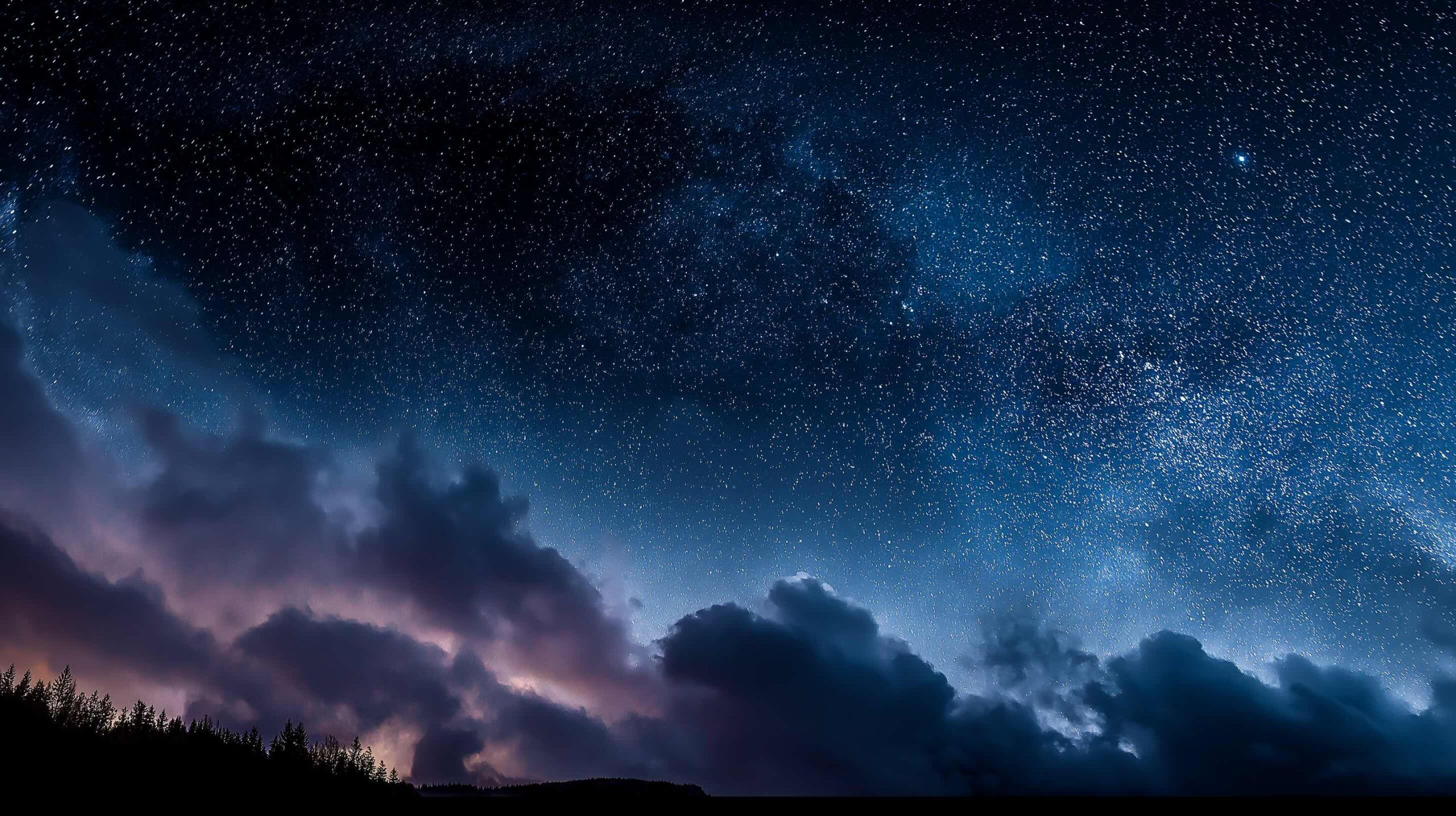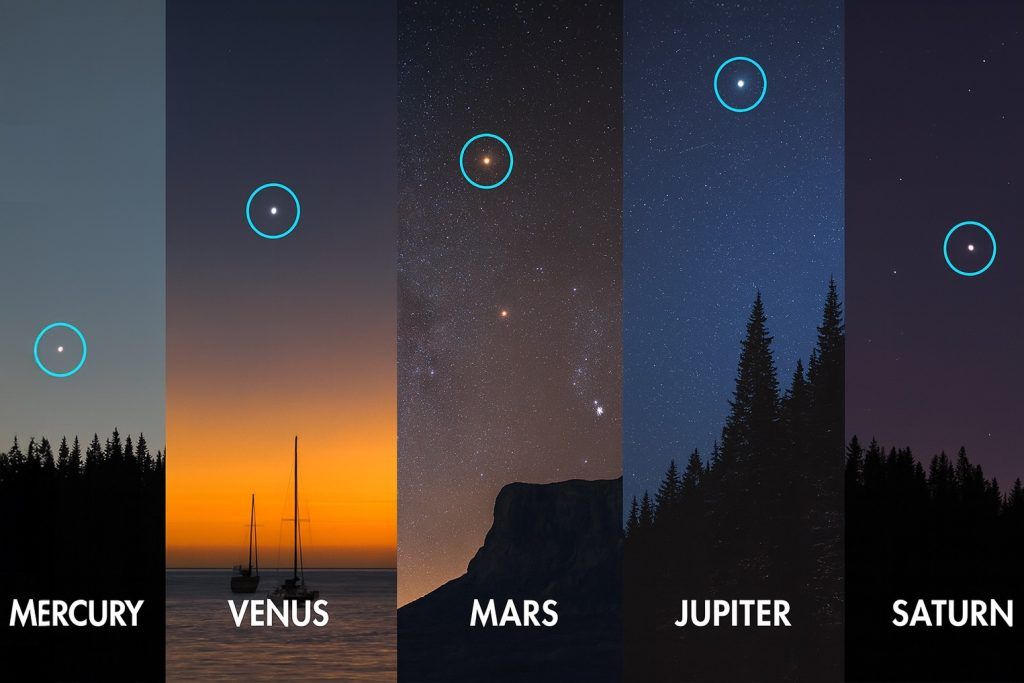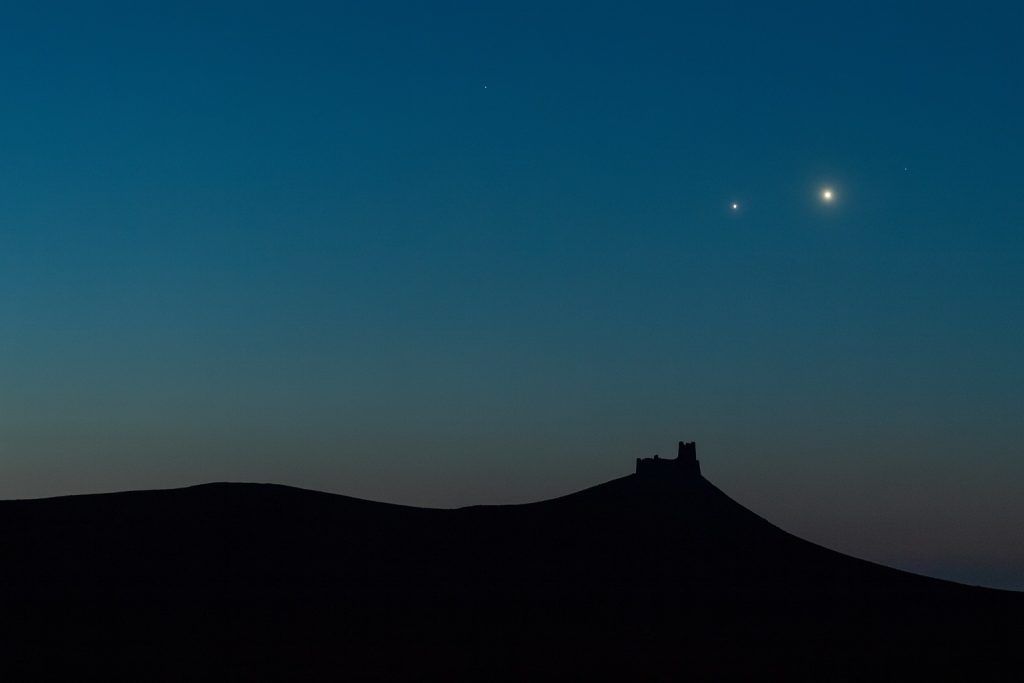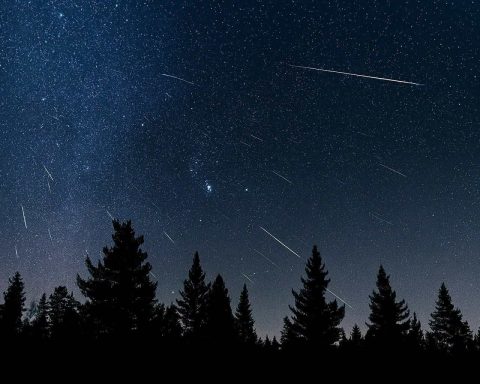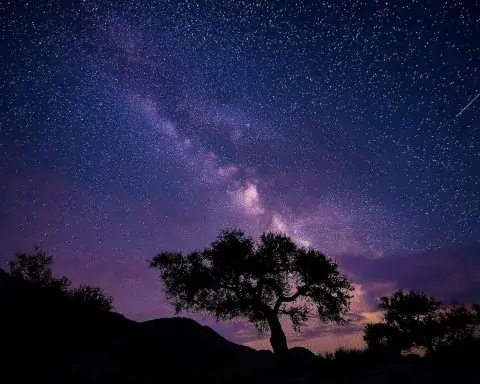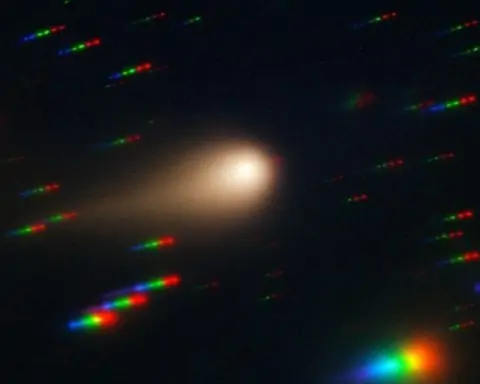- On August 23, 2025, the Moon undergoes a seasonal Black Moon New Moon in Virgo at 06:06 UTC, the third New Moon in a season with four.
- The Dumbbell Nebula, M27, in Vulpecula is a bright planetary nebula visible throughout August 2025 and was first discovered by Charles Messier in 1764.
- Mars in August 2025 has a brightness of about magnitude 1.6 and a disk roughly 5 arcseconds across.
- Mars makes a close approach to Beta Virginis (Zavijava) on August 2, 2025, passing about 8 arcminutes to the southeast.
- By August 24, 2025, Mars will be about 2.7° south of Porrima (Gamma Virginis) with Spica roughly 13° away.
- The first Titan shadow transit across Saturn occurs on August 3, 2025, with ingress around 2:04 a.m. EDT and completion near 5:12 a.m. EDT.
- The second Titan shadow transit occurs on August 19, 2025, with ingress around 1:26 a.m. EDT and the shadow clearing Saturn around 6:30 a.m. EDT.
- Titan’s shadow across Saturn spans about 0.8 arcseconds, and Titan itself shines at magnitude 8.5.
- Saturn’s rings are tilted about 3° toward Earth in August 2025, making moon shadows easier to see against the planet’s disk.
- The Titan shadow-transit series continues through early October 2025, with no further Titan transits until the 2040s.
August 2025 offers a stellar lineup of celestial events that will delight everyone from casual stargazers to seasoned astronomers. From a rare “Black Moon” New Moon that creates inky-dark skies, to a ghostly nebula glowing in the summer stars, to Mars dancing through Virgo, and even Saturn’s moon Titan casting its shadow, the night sky is packed with must-see marvels. Read on to learn when and where to look, and get expert tips on enjoying these cosmic highlights (with sources and quotes to back it all up).
New Moon on August 23 (Rare Black Moon) – Ideal Dark Skies for Deep-Sky Viewing
The Moon goes completely dark on August 23, 2025, entering its New Moon phase in the constellation Virgo. Uniquely, this particular New Moon is a “seasonal Black Moon,” meaning it’s the third New Moon in a season that has four – a relatively rare calendar quirk that happens only about once every 33 months [1]. (Most seasons have just three New Moons, so this extra one earns the “Black Moon” moniker.) For most of the world the Black Moon falls on August 23 (UTC time 06:06 on Aug 23), though far western time zones actually experience it late on August 22 [2]. Of course, a New Moon – “Black” or not – is not visible at all (the Moon is between Earth and Sun with its dark side toward us). But what is visible is everything else: with no moonlight to flood the sky, stargazers get exceptionally dark nights around this date [3]. In fact, astronomy educators note that a New Moon night provides “some of the darkest skies of the month, perfect for observing planets, stars, deep-sky objects, and the Milky Way” [4]. In other words, August 22–24 will be prime time to head to a dark location and soak in faint wonders like the Milky Way’s starry band and distant galaxies [5]. (It’s no coincidence that many astronomers plan their hardest observations for the New Moon – dim objects are much easier to spot in a moonless sky [6].) So if weather permits, be sure to take advantage of this late-August “black sky” window – your reward will be a glorious view of a star-filled heavens that our bright Moon often washes out.
The Dumbbell Nebula (M27) – A Bright Planetary Nebula in the Summer Triangle
One deep-sky target gets a special shout-out this August: the Dumbbell Nebula, also known as M27, is perfectly placed for evening viewing all month. NASA’s skywatching guide highlights that “August is a great time to see one of the easiest-to-observe nebulas in the sky,” referring to M27 [7]. The Dumbbell Nebula is a planetary nebula – the glowing remains of a Sun-like star that has shed its outer layers at the end of its life. (As NASA explains, when stars like our Sun run out of fuel, they blow off their outer layers and leave behind a hot core called a white dwarf, whose intense ultraviolet light makes the cast-off gas glow [8]. The result is a beautiful, expanding cloud – a planetary nebula – which is a glimpse of what will happen to our own Sun in about 5 billion years [9] [10]!) M27 earned the nickname “Dumbbell” from its hourglass or dumbbell-shaped appearance in photographs. It was the first planetary nebula ever discovered (by Charles Messier in 1764), and remains one of the brightest and easiest planetary nebulas to observe [11].
Throughout August 2025, the Dumbbell Nebula rides high in the sky during the first half of the night [12]. It lies in the direction of the Summer Triangle – a large asterism formed by the bright stars Deneb, Vega, and Altair. To find M27, first locate the Summer Triangle overhead after dark; then look about one-third of the way from Altair toward Deneb [13]. In that unassuming patch of sky (in the constellation Vulpecula, near little Sagitta), the nebula will appear as a small, dim patch of light. Don’t expect it to pop out naked-eye – you’ll need binoculars or a telescope – but under dark skies it’s quite detectable. In fact, in a pair of 7×50 or 10×50 binoculars you may glimpse M27 as a faint gray smudge about one-quarter the apparent width of the full Moon [14]. Through a telescope at low magnification, it begins to show its lobed, oblong shape that inspired the “dumbbell” name. (It may appear slightly bluish-green in larger scopes, due to doubly-ionized oxygen emission.) Because the Moon is out of the way late in the month, this is an excellent opportunity to hunt down M27. It’s an awe-inspiring sight to ponder: you’re seeing the delicate shell of a dying star, “a glimpse into the future that awaits our Sun” and a process that seeds the galaxy with elements for new stars and planets [15]. The Dumbbell Nebula is a rewarding midnight object that any sky enthusiast can appreciate – so if you have a chance on a clear August night, point your optics at this cosmic ghost and enjoy the view!
Mars’ Journey Through Virgo – Red Planet Meets the Virgin’s Stars
Mars is the lone evening planet of August 2025, and although it’s now far from its brilliant prime, it’s making a notable trek against the background stars of Virgo this month. You’ll find Mars low in the west after sunset, appearing as a modestly bright, orange-hued “star” in twilight. In fact, Mars has faded to about magnitude 1.6 – only about 60% as bright as it was back in May [16] [17] – so you may need to spot it early in the dusk before it sinks too low. (It’s roughly on par with some Big Dipper stars in brightness now [18].) Throughout August, the Red Planet glides across southwestern Virgo [19], passing near several of the Maiden’s notable stars. On August 2, Mars has a close encounter with Beta Virginis (a 4th-magnitude star also known as Zavijava). On that date the planet will stand only about 8 arcminutes (0.13°) southeast of Beta Virginis – a tight pairing visible in binoculars [20]. Look toward the west about an hour after sunset; Mars and Beta Virginis should appear roughly 10° above the horizon at that time (about the width of your fist at arm’s length) [21]. Mars will outshine Beta Vir, but only slightly, so the two may look like a close double-star until Mars moves on.
As the month progresses, Mars continues its eastward march through Virgo. By August 24, it will arrive near Gamma Virginis, better known as Porrima – one of Virgo’s prominent stars (magnitude ~3.5). Mars will sit about 2.7° south of Porrima on Aug 24 [22]. To help locate it, note that Virgo’s brightest star, 1st-magnitude Spica, will be not far away: on the same night, Mars is roughly 13° to the lower right of Spica in the western evening sky [23]. Although Mars itself is only middling in brightness now, these close approaches provide a neat reference – you can literally see Mars’s motion week to week as it shifts position relative to these background stars. Keep in mind that Mars is quite distant from us at this time, so it’s not a good month for telescopic details on the planet’s surface (Mars appears only about 5 arcseconds wide – essentially a tiny featureless disk in most amateur scopes) [24]. But its distinct reddish color and the astronomical alignments make it fun to follow anyway. A bonus: on August 25–26, the crescent Moon will join the scene, helping point the way. On August 25, a thin young Moon will sit just to the lower right of Mars at dusk, and on August 26 the Moon, Mars, and Spica will form a lovely skewed triangle in the west [25]. EarthSky notes that on the 26th the Moon will shine between Mars and Spica, with Mars to one side and Virgo’s blue star Spica to the other [26] – a picturesque grouping worth a look (and a photo if you’re inclined!). By month’s end, Mars will be ever lower in twilight, headed for conjunction with the Sun in early 2026 [27], so enjoy the Red Planet now before it slips out of view. It’s impressive how “practically on station” Mars has remained, hanging in the same low western spot week after week [28] – a lingering farewell of sorts as this long apparition winds down.
Aug 3 & 19: Titan’s Shadow Transits Across Saturn’s Disk – A Rare Double Feature
Saturn, the ringed jewel of the sky, reaches prime time in late summer – it rises in mid-evening and shines all night in the constellation Pisces [29]. In August 2025, telescopic observers get a special treat: Saturn’s largest moon Titan will cast its shadow across Saturn’s cloud tops not once but twice this month [30]. These events – called shadow transits – are relatively rare occurrences that happen only when Earth’s line of sight is aligned with Saturn’s ring plane. Right now Saturn’s rings are tilted nearly edge-on (we see the thin south side of the rings in 2025), which means Titan’s orbit crosses in front of Saturn from our perspective. As a result, Titan’s inky black shadow can sometimes be seen trekking across Saturn’s face, much like an eclipse. Astronomy Magazine notes *“two shadow transits of Titan across Saturn’s disk are predicted for August 3rd and August 19th, observable with telescopes,” and even adds that Saturn’s rings are favorably tilted for viewing during this period [31]. In other words, if you have access to a decent telescope, mark your calendar for these dates – you can watch a tiny moon’s shadow cross a giant planet ~800 million miles away!
The first Titan transit occurs on the night of August 2–3, 2025. For North American observers, the action happens in the predawn hours of August 3. Titan’s little black shadow first touches the edge of Saturn around 2:04 a.m. EDT (give or take a few minutes) [32]. It takes about 15–20 minutes for the full shadow to move onto the disk of Saturn [33], so by ~2:20 a.m. EDT the shadow should be completely visible against Saturn’s globe. Over the next couple of hours the shadow slowly creeps across. By around 4:30 a.m. EDT, the dark dot is midway across Saturn’s face [34] – a remarkable sight if you have steady seeing. (At that moment Titan itself will be just off Saturn’s eastern limb, since the moon’s shadow slightly trails the moon’s position [35].) The shadow exits Saturn’s disk roughly around sunrise for the U.S. East Coast, finishing around 5:12 a.m. MDT (7:12 a.m. EDT) according to one report [36]. That means observers farther west (with darkness later) get to catch the latter half of the transit more easily. Notably, two smaller Saturnian moons – Enceladus and Tethys – are also transiting Saturn around the same time on Aug 3 [37]. Their tiny shadows are extremely challenging to see (they are far smaller moons), but just knowing they’re crossing is exciting. If you have a large telescope, you might try for Tethys or Enceladus silhouetted as faint specks just north of Saturn’s rings during Titan’s transit [38]. Regardless, Titan’s shadow will be the main spectacle – it’s the easiest moon shadow to see on Saturn because Titan is by far the largest Saturnian moon (its shadow spans ~0.8 arcseconds, comparable to a distant planet’s apparent size) [39].
The second Titan shadow transit comes 16 days later, on the night of August 18–19, 2025. Titan orbits Saturn once every 16 days, so these transits repeat on that schedule [40] [41]. The August 19 event will favor observers in the eastern half of North America (and South America) in the wee hours of the 19th, while still occurring late on the 18th local time for the Americas west coast [42]. In the Eastern time zone, ingress is around 1:26 a.m. EDT on Aug 19 when Titan’s shadow begins creeping onto Saturn [43]. The transit continues for roughly 2.5 to 3 hours, with the shadow crawling off the disk by about 5:30 a.m. CDT (6:30 a.m. EDT) [44]. If you missed the early August transit (or it was clouded out), this second one is a golden second chance. However, opportunities like this don’t come often – Titan’s shadow transits occur in series when conditions are right, but then disappear for years. In fact, the current series of Titan transits will conclude in early October 2025, and after that no more Titan shadows will grace Saturn’s face until the 2040s! As one Sky & Telescope observer urged regarding this season, “If I miss it this time around, the next series won’t happen for another 15 years!” [45]. So it’s truly now-or-never if you want to witness Titan’s tiny eclipse with your own eyes.
To view a Titan shadow transit, you’ll need at least a small telescope – and bigger is better. Titan itself shines at about magnitude 8.5 (visible in even a 60mm scope as a tan dot near Saturn [46]), but its shadow is essentially a minuscule black pinprick against Saturn’s bright disk. Experienced observers recommend using high magnification (200× or more) and a scope of 3 inches (75 mm) aperture or larger to discern the shadow clearly [47]. At 200×, Titan’s shadow will appear as a tiny round dot, distinct from the golden hues of Saturn’s cloud bands. Patience and steady air are key – the shadow is small, but once you lock onto it, it’s an exhilarating sight! Also, note that Saturn’s rings, while nearly edge-on, are still visible and in fact currently show a narrow stripe across the planet’s equator [48]. In August 2025 the rings are tilted only ~3° toward us [49], so they appear as a thin line through Saturn’s globe – a unique view in its own right. The dimmed rings actually make it easier to see moon shadows, since there’s less glare than when the rings are wide open. And Saturn itself is well placed for observing this month, rising before midnight and reaching high in the sky by the early morning hours [50]. All these factors combine to make Titan’s shadow transits one of the top telescope events of 2025. If you’re fortunate enough to have a telescope, don’t miss Saturn’s “shadow play” this August – you’ll be witnessing a cosmic alignment that won’t recur for a decade and a half.
In summary, August 2025 is a fantastic time to look up. From the dark-sky gift of a Black Moon perfect for Milky Way viewing, to the celestial showpiece of the Dumbbell Nebula overhead, to Mars sliding by Virgo’s stars at dusk, and the excitement of Titan’s shadow on Saturn late at night – there’s something for everyone. As always, make sure to check exact timings for your location and find a dark spot away from city lights for the best experience. Clear skies, and happy stargazing!
Sources:
- NASA JPL – “What’s Up: August 2025 Skywatching Tips” (Aug 2025) [51] [52] [53] [54]
- Star Walk (Vito Technology) – What is a Black Moon? (Aug 2025) [55] [56]
- Timeanddate – “August 2025 Hosts Rare Black Moon” (E. Elliott, Aug 8, 2025) [57] [58]
- Astronomy Magazine – “Sky This Month – August 2025” (M. Ratcliffe & A. Ling, Aug 2025) [59] [60] [61]
- EarthSky.org – August 2025 sky guide (various dates) [62]
- Sky & Telescope – “Titan Shadow Transit Season Underway” (B. King, May 2025) [63] [64]
- Sky & Telescope – “This Week’s Sky at a Glance, Aug 8–17, 2025” (A. MacRobert, Aug 2025) [65].
References
1. www.timeanddate.com, 2. www.timeanddate.com, 3. www.timeanddate.com, 4. starwalk.space, 5. starwalk.space, 6. starwalk.space, 7. science.nasa.gov, 8. science.nasa.gov, 9. science.nasa.gov, 10. science.nasa.gov, 11. science.nasa.gov, 12. science.nasa.gov, 13. science.nasa.gov, 14. science.nasa.gov, 15. science.nasa.gov, 16. science.nasa.gov, 17. www.astronomy.com, 18. science.nasa.gov, 19. www.astronomy.com, 20. www.astronomy.com, 21. www.astronomy.com, 22. www.astronomy.com, 23. www.astronomy.com, 24. www.astronomy.com, 25. earthsky.org, 26. earthsky.org, 27. skyandtelescope.org, 28. skyandtelescope.org, 29. www.astronomy.com, 30. www.astronomy.com, 31. www.astronomy.com, 32. www.astronomy.com, 33. www.astronomy.com, 34. www.astronomy.com, 35. www.astronomy.com, 36. www.astronomy.com, 37. www.astronomy.com, 38. www.astronomy.com, 39. skyandtelescope.org, 40. skyandtelescope.org, 41. skyandtelescope.org, 42. www.astronomy.com, 43. www.astronomy.com, 44. www.astronomy.com, 45. skyandtelescope.org, 46. www.astronomy.com, 47. skyandtelescope.org, 48. skyandtelescope.org, 49. skyandtelescope.org, 50. science.nasa.gov, 51. science.nasa.gov, 52. science.nasa.gov, 53. science.nasa.gov, 54. science.nasa.gov, 55. starwalk.space, 56. starwalk.space, 57. www.timeanddate.com, 58. www.timeanddate.com, 59. www.astronomy.com, 60. www.astronomy.com, 61. www.astronomy.com, 62. earthsky.org, 63. skyandtelescope.org, 64. skyandtelescope.org, 65. skyandtelescope.org
